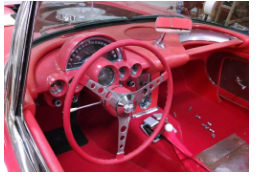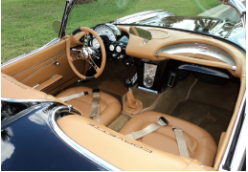For classic car enthusiasts, your car seat’s leather covering might be cracked and partially coming apart, the foam could be sagging and frosty, or the leather could be faded. In such a situation, most people wonder whether they should ‘fix it, restore the upholstery, or do a complete replacement’. Classic car upholstery does not simply serve as decoration on a car. It is an essential part of the vehicle’s body. From maintaining a pre-dated vehicle’s restoration aesthetic to improving comfort and resale value, every decision is essential.
Below is a list in order to optimize your budget while helping you unlock your car’s potential.
1. Inspection First
Your assessment begins with an in-depth inspection of the car’s interior, such as seats, door panels and linings. Things like minor cracks and fading might be repaired easily, while algae, large rips or sagging foam are best suited for replacement.
Check For:
- Surface level vs. Structural damage
- Smell (presence of mildew or mould indicates deeper issues)
- Matching material availability for your classic car model
A thorough inspection will always highlight issues before they spiral beyond repair and save you money.
2. Returning Upholstery to Its Former Glory: Most Suitable for Preservation
If you wish to preserve everything as it is, restoration would make the most sense. This approach focuses on fixing and rejuvenating what exists. It is most efficient when the upholstery materials can be saved. It also preserves your classic car upholstery.
Restoration tips:
- Apply professional leather cleaner and conditioner products
- Re-dye faded leather or vinyl to the correct shade
- Replace worn out foam with period-correct density
- Repair rips with sewing instead of patching when possible
This method retains resale value for collectors and purists.

3. Repair: An Approach In Between
Other than severe destruction, many will opt for restoration. This option tends to be cheaper and faster than doing a full replacement.
Repair Suggestions:
- Repair small rips using matching thread and patching supplies
- Re-shrink vinyl areas with steam or heat gun
- Re-pad seat cushions while covering them with the original covers
- Individual panel substitution instead of full seat cover replacement
If executed professionally, these changes can camouflage, allowing the upholstery to remain in pristine condition for longer.
4. Alteration: For a fresh start
If the original material is far gone or if you want a different style, replacing your classic car upholstery might be a more intelligent option. This is perfect if you want something to match a full mechanical and exterior restoration that has been done.
Replacement Advice:
- Use period-accurate vinyl, leather, or cloth.
- Consider modern foam for better comfort without sacrificing looks.
- Installation should be done by shops that specialize in classic cars.
- If the original covers are intact, keep them for future resale or reference. Replacement provides the opportunity to adjust and personalize your vehicle while respecting its heritage.
5. DIY or Professional Help?
A classic car can be reupholstered or repaired by oneself only if the right experience, tools and space are provided. A professional shop guarantees proper material placement, clean stitching, and long-lasting durability.

Upholstery Excellence You Can Count On
For replacing or repairing classic car upholstery, Upholstery Excellence can assist with any hot rod. They can address any wear and tear issues with exceptional automotive upholstery vinyl, convertible tops, Hot Rods and classic cars, as well as boats, RVs, motorcycles, and even commercial upholstery. Upholstery Excellence offers high-quality craftsmanship for every vehicle.
Conclusion
So, should you restore, repair, or replace your classic car upholstery? The answer depends on your goals, budget, and how much of the car’s originality you want to maintain. Restoring is great for authenticity, repairing works for minor fixes, and replacing gives you a clean slate.
No matter what route you take, keeping your classic car upholstery in top shape ensures every drive feels as good as it looks.

